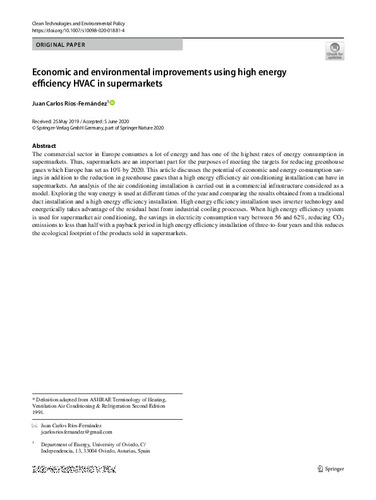Economic and environmental improvements using high energy efficiency HVAC in supermarkets
Author:
Publication date:
Publisher version:
Citación:
Descripción física:
Abstract:
The commercial sector in Europe consumes a lot of energy and has one of the highest rates of energy consumption in supermarkets. Thus, supermarkets are an important part for the purposes of meeting the targets for reducing greenhouse gases which Europe has set as 10% by 2020. This article discusses the potential of economic and energy consumption savings in addition to the reduction in greenhouse gases that a high energy efficiency air conditioning installation can have in supermarkets. An analysis of the air conditioning installation is carried out in a commercial infrastructure considered as a model. Exploring the way energy is used at different times of the year and comparing the results obtained from a traditional duct installation and a high energy efficiency installation. High energy efficiency installation uses inverter technology and energetically takes advantage of the residual heat from industrial cooling processes. When high energy efficiency system is used for supermarket air conditioning, the savings in electricity consumption vary between 56 and 62%, reducing CO2 emissions to less than half with a payback period in high energy efficiency installation of three-to-four years and this reduces the ecological footprint of the products sold in supermarkets
The commercial sector in Europe consumes a lot of energy and has one of the highest rates of energy consumption in supermarkets. Thus, supermarkets are an important part for the purposes of meeting the targets for reducing greenhouse gases which Europe has set as 10% by 2020. This article discusses the potential of economic and energy consumption savings in addition to the reduction in greenhouse gases that a high energy efficiency air conditioning installation can have in supermarkets. An analysis of the air conditioning installation is carried out in a commercial infrastructure considered as a model. Exploring the way energy is used at different times of the year and comparing the results obtained from a traditional duct installation and a high energy efficiency installation. High energy efficiency installation uses inverter technology and energetically takes advantage of the residual heat from industrial cooling processes. When high energy efficiency system is used for supermarket air conditioning, the savings in electricity consumption vary between 56 and 62%, reducing CO2 emissions to less than half with a payback period in high energy efficiency installation of three-to-four years and this reduces the ecological footprint of the products sold in supermarkets
ISSN:
Files in this item




